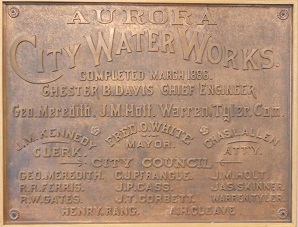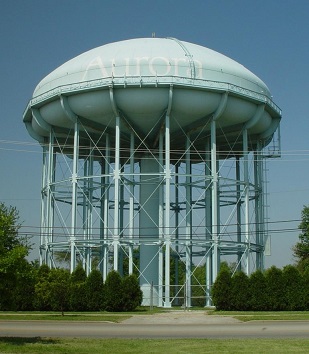

(Built 1933, demolished 2012)
| Introduction | Historical Background | Chronology | Geography | Biography | Technology | Ownership and Financing | General Bibliography |
| North
Central States |
Illinois | Aurora |
Aurora was incorporated as a city in 1857.
The first water works in Aurora were built in the late 1840s by pioneer resident Samuel McCarty. He constructed a wooden reservoir and built a square wooden pipeline that used gravity to distribute water to the east side of downtown, including hotel that McCarty owned.
By 1859 hydraulic rams were being used to pump water through lead pipes that served almost the entire business district along with local railroads. This system would not have provided enough water for fire protection and in 1869 the city built a small Holly water works system for fire protection in 1869 by purchasing a Holly pump and installing it in Carter and Hoyt's Foundry. In 1872 two more Holly pumps were purchased and installed in the Silver Plate Factory on Stolp's Island and at the City Mills located at the foot of Main Street at the river.
The city built a complete standpipe water system in 1885 and constructed a new water system in 1933.
Water is provided by the city of Aurora, which has a history page.
 |
 |
| Plaque from 1886 Water Works | 1.5 million gallon water tower (Built 1933, demolished 2012) |
References
1859 Kane
County, IL. Directory for for 1859-60
Water of the purest kind is found by digging from twelve to twenty feet,
and in the bluffs, on both sides of the river, a thousand springs of soft
water, clear a as a crystal and delicious to drink, gush forth, enough to
supply the largest city in the world, I think. By the aid of hydraulic
rams, they are made to supply, through leaden pipes, the round house and
almost the entire business portion of the east side, and a reservoir to
supply the railroad on the west side.
1877 "Aurora,
Kane County," Chicago Tribune, February 7, 1877, Page 7.
The water-works of Aurora cost but $40,000.
1878 The Past and Present of Kane County, Illinois: Containing a History of the County
1888 Sanborn Fire Insurance Map from Aurora, Kane County, Illinois. January 1888
1888 Commemorative
Biographical and Historical Record of Kane County, Illinois:
Containing Portraits and Biographical Sketches of Prominent Citizens,
Governors of Illinois, Presidents of the United States, Also
Containing a History of the County
Pages 947-948: In 1867, the question of Holly water works was
agitated by the city, and under a resolution to introduce that system of
protection from fire into the city, the Eagle Mills, with one square foot
of water, and the privilege of all in the river in case of fire, were
purchased by the city.
In May, 1869, a vote on taxation for a fire department was defeated
by 667 to 98. The council, at a meeting soon following (May 18), voted to
appropriate $12,000, then in the treasury, for fire purposes, establishing
a fire department, purchasing an Amoskeag steamer, hose, hose cart, etc.,
placing one-third the amount at the disposition of the West Side and
two-thirds at the East Side. The steamer, named “City of Aurora” and
weighing 6,000 pounds, arrived the latter part of June, 1869. A Holly pump
was put in R. L. Carter & Co.'s shops, and 864 feet of pipe laid in
the business portion of the West Side, numerous hydrants were set, etc.,
and the result was very satisfactory. Three large cisterns were built on
the East Side, late in 1869, to supply the steamer, costing $400 each. The
Holly system was subsequently extended to take in the business portion of
the East Side, and an additional wheel for power was put in the City
Mills.
The growing needs of the city in time demanded something which should be
more widely beneficial than the Holly system as it existed could be, and
the subject of water works came under earnest discussion. Finally, Chester
B. Davis, a Chicago engineer, was employed to prepare plans for a system
of water works, said plans being accepted by the city. At a meeting of the
common council June 5, 1885, it was decided that the city should own and
control the system, and measures Bonds were issued to the amount of
$138,000, bearing 5 per cent interest, one-half the amount payable in ten
and the remaining half in twenty years. The entire amount was subscribed
by N. W. Harris & Co., of Chicago, who paid $3,100 premium for the
bonds. Contracts for the various portions of the work were let to the
amount of $110,876, and ground was broken for the laying of the mains, on
the West Side, August 7, 1885. The work was completed in March, 1886, the
last work being the laying of the connecting main across Fox River, at the
lower end of Stolp's Island. A thorough test was made and the works
finally accepted by the city. Upon their completion there were over 20
miles of mains, 245 hydrants, a steel standpipe 152 feet high and 18 feet
in diameter, with a capacity of 283,000 gallons, 2 steam pumps with a
capacity of 3,000,000 gallons daily, the necessary pumping station, etc.
Considerable extensions were made beyond the original plans, and the
entire cost has been in round figures about $165,000. The efficiency of
the works has been often demonstrated in case of fire, and thousands of
dollars' worth of property saved from destruction through their agency.
1888 "Aurora," from Manual of American Water Works, Volume 1.
1889 Samuel McCarty (1810-1889) grave. Built the first water works in Aurora.
1890 "Aurora," from Manual of American Water Works, Volume 2.
1891 Sanborn Fire Insurance Map from Aurora, Kane County, Illinois. October 1891
1891 "Aurora," from Manual of American Water Works, Volume 3.
1897 Sanborn Fire Insurance Map from Aurora, Kane County, Illinois. November 1897
1897 "Aurora," from Manual of American Water Works, Volume 4.
1907 Sanborn Fire Insurance Map from Aurora, Kane County, Illinois.
1908 History
of Kane County, Ill, Volume 1, by Rodolphus Waite Joslyn and
Frank Wilber Joslyn
Page 563: In 1869 the Holly pumps were established on both sides of
the river, a hose house built and a company organized and located in River
and Galena streets. A Holly pump was put into Hoyt's shop to pump water
into the West Side mains and into the city mills for the East Side. The
old Eagle mill site at the north end of the island was first tried, for
the city owned one hundred and forty-four cubic inches of water then, but
this power was insufficient to work the pump. After many years a hose
house was built in South Lake street.
1909 "Earthquake
Damaged Aurora Standpipe," Dixon Evening Telegraph, June 4,
1909, Page 2.
The top of the pipe is 14 inches off the plumb line. It is about 150
feet high.
1950 Sanborn Fire Insurance Map from Aurora, Kane County, Illinois. January 1950
A
brief written history of the Aurora Fire Department, by Lt.
and Mrs. Charles Goodwin, Aurora Regional Fire Museum
The citizens on the West Side felt they were entitled to fire protection
and were in favor of forming a second fire company and installing a “Holly
System”. This was a system in which stationary high pressure “Holly Pumps”
pumped water from the river directly into water mains and fire hydrants.
Another group of citizens wanted to sell the Young America fire pumper and
buy a new steam fire engine.. Lengthy debates were held over several years
without coming to a conclusion. Finally, during an election held May 15,
1869, the voters were simply asked if they were in favor of or against a
fire department supported by taxation. The proposal to have tax supported
fire department was defeated by a 98 to 667 margin.
This group of city officials were not to be denied though and immediately
after the election, they "found" $12,000.00 in the Treasury, which they
appropriated to establish a fire department. Two-thirds of the money went
to the East Side – they bought a steam fire engine, hose cart, hose and
brass couplings. The balance of the funds went to the citizens on the West
Side who favored the Holly System.
A fire company called the "Holly Hose Company" was formed and the Holly
pump was purchased and installed in Carter and Hoyt's Foundry, located on
the Fox River between Downer Place and Galena. A corner of the foundry
property was leased by the city and a two-story frame building in which to
store the hand-drawn hose cart, hose and other equipment was erected. John
Eddy, who eventually to become Chief Engineer of the Aurora Fire
Department, was elected as the first Foreman of the Holly Hose Company.
n 1872, the Holly water mains were extended to the business district on
the East Side of the river. Two more Holly pumps were purchased and
installed in the Silver Plate Factory on Stolp's Island and at the City
Mills located at the foot of Main Street at the river. Also in 1872, the
Holly Hose House was moved to a new location on the east side of South
Lake Street between Downer Place and Holbrook Street (now West Benton
Street) and Aurora sold the Young America hand pumper to Benton Harbor,
Michigan for $800.00. A hand-pulled hose cart was bought for the Excelsior
No. 2 Fire Company, which they used until a steamer was purchased for them
in 1875.
During 1885, Aurora made a major development in fire protection with the
installation of a water works system. The 20 miles of water mains with 245
hydrants brought water to all of the city. As Aurora expanded, the water
system also expanded to meet the needs.
City
of Aurora Water Works History
During the late 1840s Samuel McCarty constructed Aurora's first water
system. Along the foot of a bluff located near what is now Lincoln and
Spring Street, several springs flowed out of the ground. Area residents
would gather water from these springs for drinking. It was from these
natural springs that Spring Street was named.
From the largest spring, named McCarty Spring, Samuel McCarty constructed
a crude water system by building a reservoir of timbers and tapped it with
a square wooden pipeline. The wooden water main flowed by gravity and
provided water to the east side of the downtown, including the McCarty
Hotel (later known as the "Aurora," and still later as the "Tremont").
Also connected were business houses and the Empire house. This spring
flowed until about 1915 when it diminished in flow and was condemned
during a typhoid fever epidemic.
© 2019 Morris A. Pierce